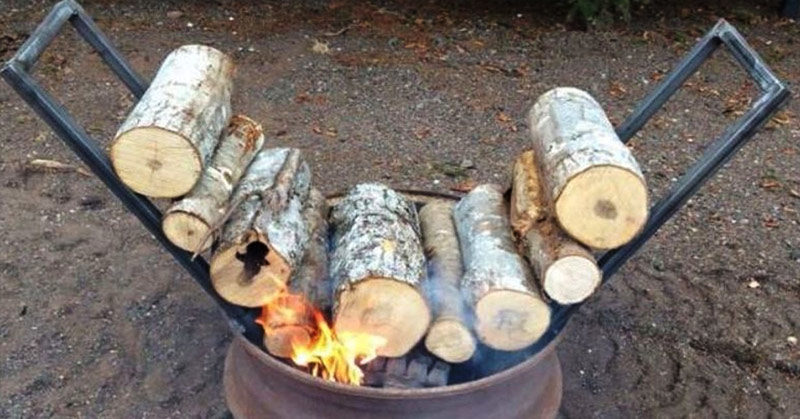Campfires are synonymous with summer. It wouldn’t be a proper camping trip without roasting marshmallows and hot dogs, and telling stories around the fire until late into the evening.
Fires do, however, require constant maintenance, attention, and work, or else they’ll burn out. They need constant stoking, and you have to continuously add kindling and new logs to keep the flame burning. One man, however, said enough is enough, and came up with his own self-feeding fire design so that campers can just sit back and relax and enjoy the glow without so much work.
Self-Feeding Fire
Bob Hansler is an outdoorsman who operates a Youtube channel where he posts videos demonstrating survival and primitive technology, wilderness skills, and bushcraft. He is the mastermind behind the self-feeding fire, which he says can burn for over fourteen hours.
The design involves creating two “ramps” positioned on either side of the fire pit. The logs are stacked along each ramp, with the idea that the ramp will self-feed the logs into the bottom as they each burn through.
To build your own, you don’t need any special materials, as you can see from the photos, Bob built his from just a few sturdy sticks. Not only did Hansler’s fire last for fourteen hours, but it also survived a downpour of about one and a quarter inches of rain- an impressive feat for a campfire [1].
You can watch the whole video below.
Read: Tutorial: Build an amazing DIY pergola and fire pit with swings
Campfire Safety Tips
While campfires can be fun, they can also be dangerous if not tended to properly. Be sure to keep the following things in mind during your next camping trip:
Know the rules. You should be well-aware of the fire regulations for the area where you are setting up camp. Remember that these rules change depending on the weather and the time of year, so pay attention to posted signs and ask if you’re not sure [2].
Always use a pit. Most campsites offer fire pits and if they do, use them. If you’re somewhere where fires are allowed but a pit is not provided, be sure to dig your own that is in an open area that is away from overhanging branches, power lines, or anything that could potentially catch fire. After digging your pit, circle it with rocks and ensure that there is a ten-foot radius around the pit that is clear of anything that could catch fire [2].
Put out the match. If you use a match to start the fire, make sure that it is completely out before getting rid of it. You can either pour water over it, or simply throw it directly into the fire. Never use lighter fluid, gas, or any other flammable liquid to start a fire, as these could get out of control [2].
Keep water close by. Always have a bucket of water and a shovel close by when you build a fire. You can use the water to put out any flames that get away from the pit, and a shovel can be used to throw sand or dirt on top of any flames that escape the ring. Keeping a few feet of ground surrounding your fire damp is also a good way to prevent the fire from travelling [2].
Read: This Awesome Tent Cot Means No More Sleeping On The Cold, Hard Ground When Camping
Watch the wind. A strong breeze can blow your fire out of control quickly, so make sure you have nothing flammable within fifteen feet of the fire, including your campsite and clothing [2].
Never leave a fire unattended. As mentioned, a strong, sudden breeze could take your fire out of control in an instant, so it is important that you have at least one set of eyes on the fire at all times so you can react quickly if anything goes wrong [2].
Always extinguish your fire properly. It is crucial that when you’re done with your fire you put it out properly every time. Dump water on it, stir the ashes with a shovel, then dump water on it again. You should not leave the fire until it is cold- the general rule is that if it is too hot to touch, it’s too hot to leave. Make sure you thoroughly soak larger logs with water, and move the rocks that make up your ring around to check underneath for burning embers. You should also never bury coals underneath, since they could smoulder and catch fire again [2].
Keep Reading: Fire Safety Tips for Preventing House Fires, from the Laundry Room to the Kitchen

